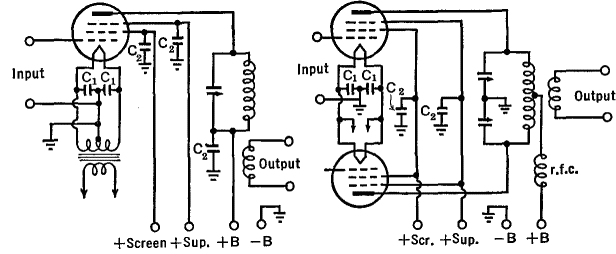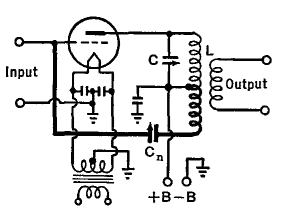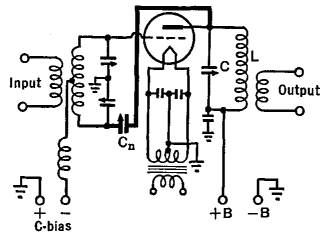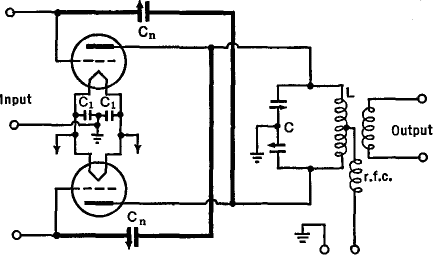| Basic Radio is a free introductory textbook on electronics based on tubes. See the editorial for more information.... |

|

Home  Amplifiers Amplifiers  R.F. and I.F. Amplifiers R.F. and I.F. Amplifiers  Neutralization Neutralization |
||||||||||||






|
||||||||||||
|
NeutralizationAuthor: J.B. Hoag Amplifier circuits tend to oscillate because of the feedback through the inter-electrode capacitances of the tube itself, because of the electrostatic and electromagnetic feedback external to the tube, and because of improper connections whereby currents of the input and output circuits flow through a common wire or through a portion of the shields from one grounded point to another. This is particularly true of radio frequency amplifiers which have tuned-grid and tuned-plate circuits. The feedback through the tube itself is largely alleviated by using tetrodes and pentodes, with condensers (C2 of Fig. 27 E) shunting r.f. currents directly to ground from the screen and suppressor grids.
Neutralization consists of feeding some of the r.f. voltages from the output or from the input of the amplifier to the other side in such a manner as to cancel the r.f. voltage developed through the grid-to-plate capacitance of the tube itself. There are three main methods, called plate, grid, and inductive neutralization.
In the plate-neutralized circuit of Fig. 27 F, the r.f. voltages in the tank circuit LC induce voltages in the closely coupled extension of L. These voltages are of opposite polarity to those on the grid (which originally caused them). They are fed back to the grid through the neutralizing condenser Cn, to balance that which reaches the grid through the grid-plate capacitance of the tube. Neutralization is satisfactory only over a small range of frequencies.
In the grid-neutralized circuit of Fig. 27 G, the rise and fall of the plate potential is transferred by the neutralizing condenser Cn through the grid coil, to counteract the voltage changes transferred by direct capacitive coupling inside the tube from plate to grid. In general, grid neutralization is less satisfactory than plate neutralization.
Figure 27 H shows an inductive-neutralization circuit, whereby " link coupling " is used between the grid and plate circuits. This type of neutralization is also complete at only one frequency.
Two condensers (CnCn) are needed to neutralize a push-pull circuit, as in Fig. 27 I. The capacitances of the two condensers are nearly equal to each other and to the tube's grid-plate value. When the tubes are electrically identical and the circuits are layed out symmetrically, neutralization can be complete and also be independent of frequency. At the very high frequencies, push-pull circuits are the only type which can be satisfactorily neutralized. In order to neutralize an amplifier, the filament is heated and r.f. is applied to the input terminals. The plate voltage is to be zero. A d.c. milliammeter is connected in series with the C-bias circuit. The plate tank circuit is tuned back and forth through resonance and Cn is adjusted until the d.c. grid current no longer changes, or, at most, shows a small gradual rise and fall, with a maximum at resonance. The circuit is then neutralized.
|
||||||||||||
Home  Amplifiers Amplifiers  R.F. and I.F. Amplifiers R.F. and I.F. Amplifiers  Neutralization Neutralization |
||||||||||||
Last Update: 2009-11-01






